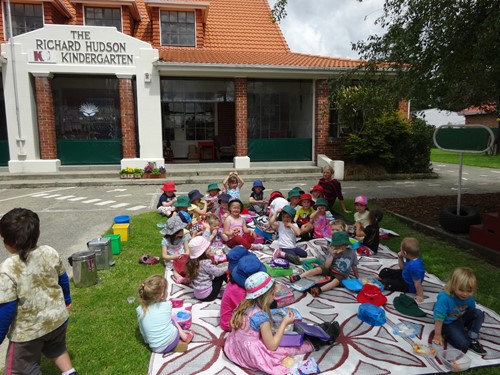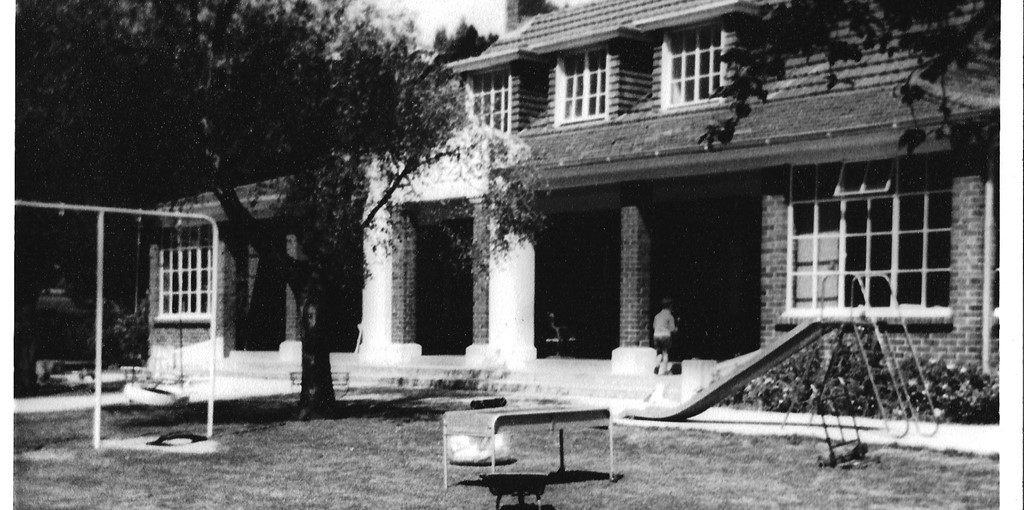Richard Hudson Kindergarten, Dunedin, NZFKU Kindergarten Buildings Album, Ruahine Kindergarten Association Archives.
Post-World War 11 spurred rapid expansion of kindergarten provision that saw increased involvement of Government in the movement and from 1958 the requirement that kindergartens be established only in specially designed buildings.
Photographs and documents of the built heritage comprising buildings and grounds of the kindergarten movement show developments from the late nineteenth century until today. Whilst the content is largely of the non-compulsory kindergarten sector, examples of early infant schools and classroom interiors operating kindergarten pedagogy are also included. Ideas as to what constitutes a kindergarten building and how the grounds should be developed vary considerably across time. Here is just a taster of the diversity of kindergarten buildings and outdoor environments in New Zealand, both rural and urban, both historical and contemporary.
We explore the architecture of the kindergarten movement, both of the buildings that remain, and some that no longer exist. Kindergarten buildings have changed over time both in general and for individual kindergartens. For example what is now named Richard Hudson Kindergarten initially operated in Caversham Presbyterian Church Hall. It later shifted initially to a City Council Cottage and in 1926 to an architecturally designed building and renamed Richard Hudson Kindergarten. A gift by the Hudson family as a memorial to their father. Wellington’s first free kindergarten opened in 1906 in the Baptist schoolroom before moving to St Peters’ Mission Hall and later to rented first floor premises on the corner of Taranaki and Frederick Streets. In 1919 Taranaki Street kindergarten moved to adapted premises at 196 Taranaki Street. At the opening the Wellington Free Kindergarten Association celebrated two firsts: the first kindergarten to gain permanent premises and the first to have its own outdoor play area and garden.
The housing of kindergartens in temporary premises before gaining permanent buildings is a common feature in kindergarten history. New purpose build kindergartens required extensive community planning, lengthy fundraising, regular working bees and persistence by small local committees of interested parents. Community based effort provided the impetus, assisted by voluntary donations from parents and by subsidy grants from the Government on approved initial equipment and furniture.
Post-World War 11 spurred rapid expansion of kindergarten provision that saw increased involvement of Government in the movement and from 1958 the requirement that kindergartens be established only in specially designed buildings. Purpose build kindergarten buildings were built in accordance with Government regulations and under the control of the Education Boards. The legacy of this period saw the majority of kindergartens with good outdoor indoor flow and built typically on ¼ acre sections. The downside was the commonality of the building plans used. The late 1980s saw responsibility for buildings restored to kindergarten associations and a resulting greater variety of building styles reflecting local needs and wants.
Kindergarten provision also operated outside standard kindergarten buildings. The 1970s saw the establishment of mobile kindergarten units to transport the kindergarten to children in rural areas to meet the aim that all children should access to kindergarten provision. Earlier still a kindergarten programme operated through the airwaves that between 1950 – 64 brought to children in homes throughout New Zealand, “Kindergarten on the Air”. A contemporary example of kindergarten outside the classroom are forest kindergartens operated by groups of teachers who saw that their children needed more outdoor room to play and learn. Whatever the weather, children are encouraged to play, explore and learn in a forest or natural environment.
Outdoor areas are built environments that, like kindergarten buildings, change over time to reflect shifts in broader cultural, economic and social beliefs. Friedrich Froebel’s system of kindergarten education was built around the notion of a garden of children, producing a powerful metaphor of the child as growing like a plant. Here the name Kindergarten signifies both a garden for children, a location where they can observe and interact with nature, and also a garden of children, where they themselves can grow and develop in freedom from arbitrary imperatives.[i] Gardens and the outdoors have been central to kindergartens and their typically spacious grounds provide children with important experiences and learning opportunities alongside space for physical activity.
Ideas about what constitutes a quality outdoor area have also changed over time. The implementation of changes in safely regulations brought the demise of paddling pools, old cars and jungle gyms. The centrality of fixed equipment shifted to greater emphasis around the natural environment to foster children’s connection with nature. Today’s outdoor environments seek to capture children’s imagination with inviting paths that circle and loop, boulders and logs to play with, slopes to run up and roll down and things to challenge the senses. Sustainability is a key focus.
Kindergartens have extended the Froebel heritage with a range of sustainability projects that aim to encourage an ethic of caring for the environment.

‘Caring for our environment’, Richard Hudson Kindergarten. 2016. Dunedin Kindergarten Association
[i] View the Froebel website here.


